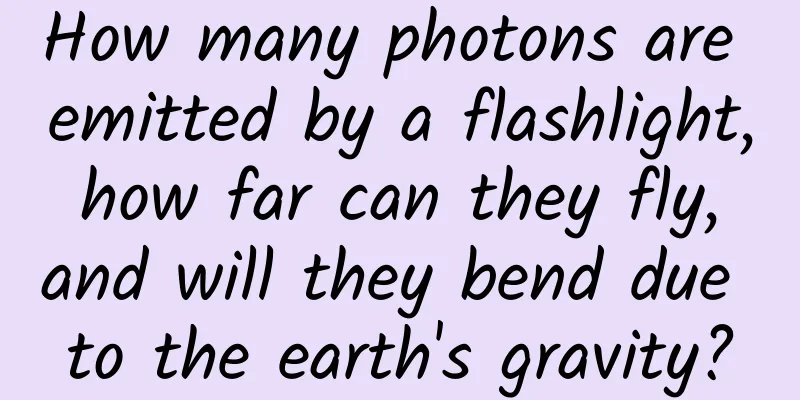How many photons are emitted by a flashlight, how far can they fly, and will they bend due to the earth's gravity?

|
This article is based on answering similar questions from netizens, see screenshot: Simple answer: Light will be emitted in a way that is infinitely close to a straight line. Light will be bent by the pull of gravity, but the source of gravity must be very huge. The gravity of the earth is too small to be basically negligible for light that travels at about 300,000 kilometers per second. This is because the Earth's gravity is too small for light. Gravity works on all matter with electromagnetic force. Light is in the category of electromagnetic force, and photons are the medium of electromagnetic radiation, so they are also affected by gravity. Although photons have no static mass, they have dynamic mass. Gravity is a phenomenon caused by the distortion of space-time by mass, so it is natural for light to be affected by gravity. Einstein's general theory of relativity believes that any object with mass will distort the surrounding space-time. Small mass will result in small distortion, while large mass will result in large distortion. Due to the movement of objects, the curvature of space-time is formed in various ways, but in general it is like forming a vortex or trap around itself. Any object passing through this vortex or trap will be affected. The larger the celestial body, the greater the curvature it forms, the deeper and more intense the vortex or trap. Approaching small celestial bodies tend to fall into this trap or vortex. If their speed is not fast enough, they will fall into the abyss, which will manifest as being pulled by gravity and eventually falling onto the large celestial body. The speed mentioned above means that the faster the object is, the greater the probability of escaping the gravitational vortex or trap. The speed of escaping a celestial body's gravitational trap is called the escape velocity. The formula for calculating the escape velocity is: v=√(2GM/R), where v is the escape velocity, G is the gravitational constant, M is the mass of the celestial body, and R is the distance between the escaping object and the celestial body's center of mass. The mass of the Earth is about 6*10^24kg, and the radius is about 6371km. According to the formula, we can calculate that the escape velocity from the Earth's surface is about 11.2km/s. In other words, on the Earth's surface, as long as you reach a speed of 11.2 kilometers per second, you can escape the Earth's gravity. The speed of light is 300,000 kilometers per second, which is about 27,000 times that of 11.2 kilometers. The Earth's gravity is almost negligible for light. The mass of the sun is 330,000 times that of the earth, and the surface escape velocity is 617km/s, which has little effect on the light of 300,000 kilometers per second. Otherwise, the sun's light would have been circling around the sun, and how could it reach the earth? However, the sun's gravity is much stronger than the earth's. Therefore, many scientists observed the starlight passing near the sun during a total solar eclipse and found that the deflection was about 1.66", which is basically consistent with the calculation of Einstein's general theory of relativity. Therefore, the light from the flashlight that is directed toward the sky will be almost completely straight. In quantum mechanics, visible light is composed of photons, which have the dual nature of wave and particle. There is no definitive conclusion on the lifespan of photons, but most people believe that if the lifespan is infinite, then the light from this flashlight will theoretically float in the universe forever. Is this really the case? No. In fact, after this beam of light is emitted, it completely dissipates and disappears in just a few seconds. There are roughly three reasons for the dissipation of this beam of light: 1. The photons collide with other particles, interact with each other and change their trajectory; 2. The flashlight scatters, diluting and dispersing the photons; 3. As the distance increases and the universe expands, the light waves are gradually stretched and become invisible electromagnetic waves. Let’s discuss these three reasons: When photons encounter other particles, they will be scattered, diffracted, absorbed and transformed. Theoretically, after the light is emitted, even if you turn off the flashlight, the light will continue to fly like a cannonball if there is no obstruction. Because the speed of the cannonball is very low, it will be pulled by gravity on the earth and blocked by air resistance, so its flight trajectory is a parabola and it will fall down not far away. But the speed of photons is 300,000 kilometers per second, and the gravity of the earth is almost negligible, so they will keep flying unless they encounter obstacles. In fact, after light is emitted, there are indeed many obstacles along the way. In the atmosphere, it is mainly blocked by atmospheric molecules and dust. When photons encounter various material particles, reflection, diffraction, scattering or absorption will occur, and a beam of light will continue to attenuate. The light emitted by a flashlight into the sky must first pass through the dense atmosphere. The density of the surface atmosphere is 1.293kg/m^3, and each cubic centimeter contains about 2.6875*10^19 atmospheric molecules, which is about 1.7 trillion. When photons travel in such a dense atmosphere, they will of course be absorbed and dissipated quickly. When encountering reflection, refraction, or diffraction, light changes direction and naturally will not follow its original route, so the light is weakened; when a photon hits an atmospheric molecule or an electron of any atom, the energy will be absorbed by the electron. The electron will be in an excited state with the extra energy and will transition to a higher energy level. If there is no more energy to replenish it, it will transition back to its original energy level and release a photon at the same time. But this photon is no longer the original photon, and the direction of emission is no longer the same as the past route, so we can assume that the past photon has dissipated. Even if you reach space, it is not an absolute vacuum, there are still rare particles, and photons will interact with these particles and transform. As a result, this beam of light will eventually disappear. Photons are also diluted due to the diffusion of the flashlight spot. Although the flashlight has a focusing device, its focusing ability is weak. The light emitted is constantly diffused and is proportional to the distance. Different flashlights have different luminous energies and focusing abilities. Let's take a flashlight with a luminous power of 10 watts and a focusing angle of 10° as an example to calculate. A 10-watt light bulb produces 10 J/s (joules per second). Photon energy E = hc/λ, which is equal to Planck's constant multiplied by the speed of light divided by the wavelength. Visible light is a very narrow band in the electromagnetic spectrum, with a wavelength of about 380nm (nanometers) to 760nm. We take an average value of 570nm. According to the photon energy formula, the energy of each photon with a wavelength of 570nm is about 3.5*10^-19J. So the total number of photons in this beam of light with an energy of 10J/second emitted by the flashlight is about 2.86*10^19, which is 28.6 trillion photons. The light emitted by the flashlight continues to spread at an angle of 10 degrees, the spot will continue to expand, and the photons will be diluted. When the light is emitted 30 meters, the radius of the spot is about 2.5 meters, 3 kilometers, the radius of the spot is 250 meters; 300 kilometers, the radius of the spot is 25 kilometers; 300 kilometers, the diameter of the spot is 250 kilometers. At this time, even if all the photons have not decayed, how many photons are there per square meter? We calculate according to the circle area formula and find that when the flashlight is 3,000 kilometers away, the spot area is about 19,634,954,0849 square meters, and the number of photons per square meter is about 146 million. If the spot area captured by the human eye is 1 cm, then there are still 145 photons entering the retina per second. Although it is very weak, it is still visible. But on Earth, it is impossible for a flashlight to travel so far. The dense air would have attenuated the light long ago. Even if individual photons are left, it would be difficult for the human eye to perceive them. But even in space, this beam of light cannot propagate for 1 second, because the speed of light is 300,000 kilometers per second. At 300,000 kilometers, the diffusion radius of this beam of light reaches 25,000 kilometers, and the area of the light spot is 196,349,540,849,3621 square meters. The number of photons per square meter is only 14,566, and the number of photons in 1 square centimeter is less than 0.015 photons. In fact, when the flashlight light travels for 0.1 seconds and travels 30,000 kilometers, less than 1.5 photons per second can enter the human eye. For the human eye, generally 6 photons are needed to be sensitive to light, and even the best vision requires 3 photons. 1.5 photons are no longer visible. Ordinary light sources are naturally divergent in all directions. People install a focusing device on the light source to make the light propagate in one direction. Flashlights are usually ordinary light sources, so they cannot propagate farther. Lasers are naturally propagating in one direction, with a very small divergence of only about 0.001 radians, so they can travel farther. When landing on the moon in the last century, astronauts placed several laser reflecting devices on the moon. Scientists on Earth emitted lasers to these reflecting devices, and then received the reflected lasers. Based on the time taken for emission and return, they could accurately measure the surface distance between the Earth and the Moon. Of course, both the transmitting and receiving devices must use telescopes, which cannot be accomplished by human eyes. In theory, the larger the area of the telescope's primary mirror, the more photons can be focused, and the farther you can see. I won't go into details here. The speed of light moving away and the expansion of the universe cause light waves to stretch into invisible light. We know that the universe is expanding, and the farther away it is, the faster it expands. As the speed of light moves away from us and the universe expands, the wavelength will experience the Doppler effect. The so-called Doppler effect of light means that when the light source moves towards us, the frequency and wavelength will be compressed, and when it moves away from us, the frequency will be reduced and the wavelength will be stretched. Visible light is composite light, that is, light composed of multiple colors, and can be dispersed through a prism. The wavelengths are roughly divided into red, orange, yellow, green, cyan, blue, and purple from long to short. If the wavelength is lengthened, it moves toward the red end, and if the wavelength is shortened, it moves toward the blue end. In this way, the light moving away from us will form a redshift, and with the expansion of the universe, the amount of this redshift will become larger and larger, and finally move out of the 760nm wavelength range that the human eye can see, and become infrared or radio waves. Electromagnetic waves with wavelengths above infrared are invisible to the human eye. This is why people make telescopes that not only have optical structures, but also telescopes in different electromagnetic wave bands such as radio, infrared, ultraviolet, X-ray, and gamma ray. This way, they can observe distant and faint celestial bodies and make up for the lack of photosensitivity of human eyes. Therefore, the light emitted by a flashlight will quickly disappear in the universe. Although theoretically some photons may exist forever, it is difficult for people to capture them. At a great distance, even if a photon is captured, it is difficult to tell where it came from and what object emitted it. However, if a huge star or galaxy is more than 10 billion light years away from us, it can be seen by humans because the amount of photons it emits is too large and contains very high-energy X-rays and gamma rays. However, it cannot be observed with the naked eye alone, but with various large and precise telescopes, and the use of gravitational lenses in the universe. The photons of the cosmic microwave background were emitted 380,000 years after the Big Bang. They have been around for 13.8 billion years. Although they are very weak, they have been captured by scientists, which shows that the lifespan of photons is extremely long. That’s all for now, welcome to discuss, thank you for reading. The copyright of Space-Time Communication is original. Infringement and plagiarism are unethical behavior. Please understand and cooperate. |
<<: What should I do if my family or colleague is infected with the new coronavirus?
Recommend
A collection of features of 17 mainstream online marketing and promotion channels!
We have sorted out 17 mainstream online marketing...
Ma Liangkun, a famous doctor at Peking Union Medical College: A must-have course for a good pregnancy, from pregnancy preparation to postpartum care, 40 weeks of full escort
Famous doctor Ma Liangkun from Peking Union Medic...
For B-side operations, you should master the thinking patterns and common sense!
1. Discussion The reason for writing this article...
Using vegetable oil instead of milk? What is non-dairy ice cream?
Some time ago, a certain brand positioned as high...
How to realize space classroom? Post-90s astronauts build a "highway" for communication between the earth and the sky
First published: January 12, Xinhua Daily Telegra...
3 operational thinking methods to beat e-commerce promotion campaigns (Part 1)
This article mainly summarizes the author's o...
Weilai's official Weibo account denies bankruptcy rumors: pure rumor
Recently, some self-media revealed that NIO is in...
How to design a charger that saves the galaxy?
Engineer Wu has been an engineer for nearly 20 ye...
Technology Post: How to apply AI natively to Android system
[51CTO.com Quick Translation] Compared to reading...
Analysis of mobile Internet monetization methods: application distribution (Part 1)
For all developers or companies working on mobile...
Is the "green" bean soup you drink red or green?
In the hot summer, many families will cook a bowl...
Nature: How to play science in the "Tiangong"
The Mengtian laboratory module took off from the ...
The Arctic is so cold, can it catch fire?
Is the Arctic on fire? Author: Fan Gang You may f...
From "the emperor who sells dung" to "the place where grains are reincarnated", why do we apply fertilizer?
For most of the long time, agriculture, especiall...
Want to grow your user base quickly? How can you succeed if you don’t understand fission distribution!
We see more and more course posters in WeChat Mom...









